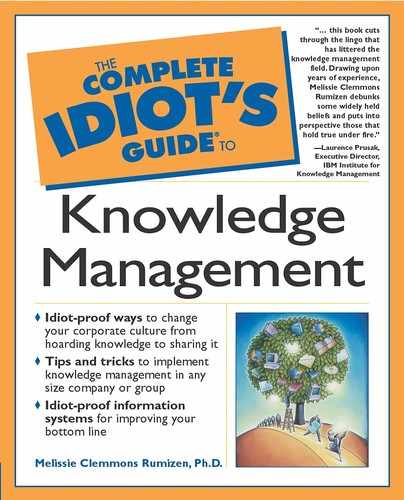
Chapter 13
Between You and Me with Collaborative Tools
In This Chapter
▶ Choosing collaborative tools
▶ Tools to facilitate working together
▶ Benefits of integrated solutions
It’s one thing to want to collaborate. But do you have the tools to do it? We count on having spreadsheets (pun intended) to do our financial calculations. We wouldn’t dream of going back to typewriters to do word processing. We expect to have electronic databases for collecting, storing, and sorting data. Yet I’ve been struck many times by the lack of similar expectations for the IT tools that make it possible for people to collaborate online, usually one of the principal goals of KM. To me, it’s the same issue: having the tools you need to do the job.
In this chapter, we’ll look at some of the electronic tools that support collaboration. We’ll start with one that I expect everyone to have—e-mail—and move up in terms of complexity and capability to support collaboration. We’ll also look at two ways to describe collaborative tools.
Characteristics of Collaborative Tools
No matter what kind of collaborative tool you use, a common framework for describing it has two elements: time and place.
▶ Time. Is the collaboration taking place simultaneously (synchronous) or at different times (asynchronous)? Some examples of synchronous collaboration are videoconferencing, and presentation support. Examples of asynchronous collaboration are e-mail and work flow. 
 Know These
Know These

Know These
Work flow refers to tools that help automate business processes. For example, insurance claims and loan processes are both business processes involving documents that need to be reviewed and approved by several people in sequence. By automating the flow of documents through the process handling, delays can be reduced significantly and the status of an individual document can be easily tracked.

Information richness is a characteristic of a collaborative tool that indicates how much information and how many types of information it has. The more information-rich a tool is, the more context it provides.
▶ Place. The collaboration can occur at the same place (collocated) or at different places (distance). Both of these can be combined, creating four sectors.

Synchronous and asynchronous tools are complementary. You need both, especially for geographically distributed teams, to be effective.
Another characteristic of collaborative tools is how information-rich they are. Information richness is the amount and types of information that a tool provides. A tool with high information richness, such as videoconferencing that includes a whiteboard, gives more context than e-mail, which has low information richness. You’re able to see facial expressions and body language. You can hear the tone and inflection in people’s voices. You can see what the room looks like where other people are.
Social presence is the last characteristic we’ll discuss. It focuses on how well the collaborative tool helps people to connect with each other. For example, a face-to-face meeting has high social presence. An e-mail message has poor social presence. Synchronous communications have more social presence overall than asynchronous. Tools with high social presence are good for solving problems, building trust and relationships, and generating ideas. My rule of thumb is that when I think a face-to-face meeting is what’s needed, that’s when a tool with high social presence is more suitable.
However, there are times when you want a tool with low social presence. Let’s say you have several people in a group who’d prefer to be meeting for a gunfight rather than a collaborative effort. Using a tool with low social presence cools the personal differences by making the people seem less real. Also, if a group is handling routine information, there’s no need to get real and personal. E-mail or some other method works fine.
The bottom line is that no one collaborative tool is ideal for all situations. Think through your goals for KM, the group who would be using it, and the suitability of your available tools. Pick what’s best for the situation.
The Lowly but Popular E-mail
Tell me, do you get enough e-mail at work? (Don’t yell.) Do you sit up at night while you’re on the road checking your e-mail? Or, at home, do you get up in the wee hours to do it? Or do you have a mobile device that beeps you while you’re in transit?
E-mail is ubiquitous. In a recent consortium benchmarking study on communities of practice, the American Productivity and Quality Center found that the most frequently used tool for communities was e-mail. Professors Peter Lyman and Hal Varian of the University of California—Berkeley estimated that 610 billion e-mails are sent worldwide per year, compared to the creation of 2.1 billion static Web pages.
E-mail is nothing more than an electronic version of written mail, now sneered at as snail mail. Messages are sent via an electronic network. Attachments can be added to include files such as documents and presentations. It also gives people a chance to think about what they want to say.
Another advantage of e-mail is that it can be used to broadcast messages to a number of people. You can even set up group e-mail addresses for groups of people you frequently contact, such as team members.

Know These
Social presence indicates how well a collaborative tool helps people to connect to each other. When a tool has high social presence, such as videoconferencing, the interactions are more social and warm. In contrast, tools with low social presence can seem distant and impersonal.

Know How
There are other things to think about when you’re picking a collaborative tool. How much time will it take to get and train employees to use the tool? How much training and technology is available? How comfortable are people in your organization with technology? Also, you may want to think about whether or not you want a permanent record, such as an e-mail.
A relative of e-mail is instant messaging. Instant messages are short text messages sent and received in a flash. Currently, one drawback is that there is little interoperability between different systems for instant messaging. For example, as of this writing AOL is incompatible with other types of instant messaging. An approved messaging standard is still needed.

Know These
Instant messaging is short text e-mail messages that are sent and received immediately. Some applications have the capability to see who else is online. Others enable the messages to be stored and resent.

Know How
People working collaboratively can have problems when it comes to using e-mail effectively. Depending on the group, you may want to mark your e-mails to show how urgent they are. You may set a time limit for reading and responding. You may agree that if someone is cc’d, he or she is not required to respond. Your group may have other issues as well.
Another way that e-mail can be used is via e-mail repositories. In these repositories, e-mails can be collected, tracked, retrieved, and reviewed.
Yet as much as e-mail is used, it’s not perfect. The most common complaint people have is that they get too much of it. Most systems do offer ways to filter messages. For example, you can route messages on which you are only cc’d to a folder to read later. Messages sent directly to you instead go to a different folder. You can route messages sent by particular people to separate folders. You also can set up which messages you want to see immediately. To me, the beauty of filters, used well, is that they sort your mail for you, much like an electronic secretary.
Another drawback of e-mail is that it is low in information richness. Effective communication is not always a matter of what you say; often it’s how you say it. In e-mail there are no facial expressions, no tone in the voice, and no winks of the eye. Without the nonverbal communications, it’s all too easy to misunderstand what someone has written. It’s also a poor way to discuss complex ideas and issues. Even something as simple as agreeing when to have a meeting is hard to do via e-mail, let alone prioritizing actions, brainstorming, or resolving conflicts.
An issue that’s becoming of greater concern is security. For example, how do you really know who sent a message? If you’ve ever been spammed with pornographic material, you know that it’s easy to disguise the true sender of a message. A digital signature can help verify the true sender of a message. Additionally, how do you know if someone or something has changed a message? This also can be handled with a software application. Depending on what you’re doing, perhaps something sensitive like new-product development, it might be something to think about and handle.
Another potential issue with e-mail is privacy. If you send e-mail at work, expect that others can look at it, regardless of whether you want them to or not. Various software platforms, as mentioned in Chapter 9, “Strategic Choices for Connecting People to People,” also tap the content of e-mail. Your e-mail can identify you as an expert, whether you want to be or not. Although such e-mail systems as the ones mentioned in Chapter 9 usually allow people to keep their anonymity, the software’s capability to search them out can threaten some people, unless handled with tact and diplomacy. Otherwise they feel as if big brother is looking over their shoulder.
E-mail is well suited for:
▶ Sending information to a group.
▶ Exchanging information.
▶ Sending and revising documents.
▶ Sending data.
▶ Defining problems.
▶ Sparking a debate.

Know These
Spam is a term used for junk e-mail. The term may have come from a skit by the British comedy group, Monty Python, in which the actors repeated the word “spam” over and over again. Or it may come from the canned meat, Spam, that can be used on anything. As with junk snail mail, your e-mail address may have been put on a list, and the unwanted messages are a nuisance.

Didn’t Know
Having a permanent record in e-mail can be a disadvantage. Microsoft is one of the organizations that learned this the hard way. In the antitrust suit against them, a mainstay of the prosecution’s evidence was Microsoft’s internal e-mail. But where there’s a market, there are entrepreneurs. Software that can make e-mail temporary is now available. Features include the ability to decide how long an e-mail will be readable or if an e-mail will be readable at all (giving people the option of sending private e-mails from work). Also, e-mails stored on a laptop can be made to vanish after a certain amount of time, which is helpful if the laptop is stolen.
Talking Together Electronically
One drawback of e-mail is that it’s hard to connect the meaning of e-mails on a particular topic scattered among other messages. Another important group of collaborative tools—message boards and chat rooms—solve this problem. Message boards (sometimes called forums, bulletin boards, or conference servers) give people the ability to post and reply to messages in a common area. Often there’s a moderator for the message board—a combination of cop, social director, and discussion leader. Chat rooms are similar, but users type comments back and forth to each other in real time.
Chat rooms and messages boards offer a number of features. Some common ones are:
▶ Threaded vs. serial discussions. A threaded discussion is one in which all replies to a message are indented and grouped under the message. This makes it easy to see what the replies to a particular message are and to follow the thread of the discussion. In contrast, a serial discussion lists messages as they are received, in no particular order. Some applications use threaded discussions, others serial. Some people hate threaded and prefer serial; others hate serial and prefer threaded.
▶ Handling of unread messages. Some applications allow the user to view the messages they haven’t read.
▶ Editing of posted messages. Sometimes users change their minds about what they’ve posted. Some applications allow users to edit what they’ve posted, perhaps in a specific time frame. Of course, other users may have already read the message. Also, some applications allow moderators to screen and delete messages.
▶ E-mail notification. Some software packages notify participants when messages get responses.
▶ Banishing of participants. If necessary, a moderator should have the ability to block someone from participating.
▶ Archiving of messages. How are the messages archived? How are they then retrieved? Also, how are archives searched?
▶ Links to other functions. For example, some applications cross-link to e-mail, chat, and instant messaging.
▶ Editing of posted messages. Sometimes users change their minds about what they’ve posted. Some applications allow users to edit what they’ve posted, perhaps in a specific time frame. Of course, other users may have already read the message. Also, some applications allow moderators to screen and delete messages.
▶ Registration systems. Depending on the software package, there may be no security features or strict confirmation of new users. You’ll have to check the specific packages you’re considering using.
▶ Spell checkers. This is a pet peeve of mine. It is beyond me why so many applications don’t include spell checkers in message boards. But they don’t.
Message boards are good at:
▶ Giving people a meeting place, much like a café.
▶ Solving problems.
▶ Sharing information.
▶ Meeting other people.
▶ Learning who the experts are.
▶ Learning about the topic.
Chat rooms work well for:
▶ Solving problems in real time.
▶ Providing more social presence than message boards.
▶ Holding scheduled events.
▶ Building communities.
Electronic Meeting Systems
Another step up from chat rooms and message boards are electronic meeting systems. I remember years ago going to a special team room to use an electronic meeting system. Each of us sat at a computer and typed in our input. All input then was displayed anonymously, helping to skirt any personality clashes in the group or a tendency for one person to dominate. We also used the system to vote on issues. Such systems are still in use, and they can range in complexity. Some are simple polling systems while others have the ability to collect input from the group members and display it on a central screen. Such electronic meetings systems also are now available on WANs, intranets, and the Internet. Such a system is good for
▶ Dealing with controversial issues.
▶ Helping a group with many conflicts to work together.
▶ Generating and prioritizing options.
▶ Defining problems.
▶ Reaching consensus.
▶ Creating a permanent record.
These systems are also becoming more compatible with other work tools, to include project-management software, spreadsheets, presentation software, and word processing. If needed, these systems can be integrated with other systems such as desktop video. The combination of electronic meetings systems with other tools increases information richness and, depending on the tool integrated, the social presence as well.

Know Nos
Don’t use an electronic meeting system without a facilitator. A facilitator plans the meeting, including developing the agenda. Once the meeting starts, the facilitator keeps the discussion on track, makes sure that everyone participates, and changes the agenda if necessary. A facilitator also handles conflict and helps resolve problems.
Working Together
In addition to electronic meeting systems, there are a number of tools that make certain activities easier for groups, whether you have teams, work groups, or communities. We’ll look at shared documents, shared databases, and electronic whiteboards.
Shared Documents
When a group is working on the same document or group of documents, there needs to be a way to
▶ Make the document centrally available.
▶ Allow people to make changes, if permitted.
▶ Synchronize the changes made.
▶ Maintain the most up-to-date version.
A variety of software packages can provide these functionalities. The benefits are obvious to anyone who has tried using e-mail to create a group document. It’s just too hard to keep track of the changes, not to mention who did what and what the most current version is.
Shared Databases
Shared database systems were some of the first collaborative tools to come out. Such systems usually can handle many kinds of data, including multimedia. Such systems are good for
▶ Storing the work of individual members.
▶ Storing the work of the group, such as lessons learned, reports, and other documents.
▶ Accessing and saving information from other sources like organizational databases.
The Electronic Whiteboard
An electronic whiteboard is similar to the whiteboards and blackboards you’re used to scribbling on. However, an electronic whiteboard gives a group the ability to share documents and drawings. I’d suggest using these with a communications link, such as voice, audio, or video. That way the group can discuss what’s being displayed on the whiteboard. An electronic whiteboard works well for these tasks:
▶ Preparing information
▶ Displaying and analyzing data
▶ Generating and listing options
▶ Drawing concepts and other visual ways to express ideas
▶ Brainstorming
▶ Creating a permanent record
Similar in nature to shared whiteboards are applications that enable users to share PC screens, such as NetMeeting. This goes beyond the shared whiteboard, though, to enable users to tap into their software applications as they collaborate. I once had a virtual meeting with someone to look at his intranet. We talked by phone while I looked at his screen as he surfed through his Intranet. It saved me a trip and got me the information I needed.
Videoconferencing
One collaborative tool that has both high social presence and information richness is videoconferencing. It comes in two flavors: specialized video facilities and desktop.
Your organization may have specialized videoconference facilities that are set up with the hardware and data links needed. Vendors also provide such facilities if your organization doesn’t want to invest in the technology. Either way, a specialized videoconference facility usually has a data link that provides high bandwidth (allows more data to flow faster through communication lines) for better quality. It also may have video equipment. However, even with high bandwidth the transmission still may not be the best for a number of reasons, particularly if you have more than two locations linked together.

Know How
The cousin of the videoconference is the audio conference, which is voice transmission only. While a videoconference with its combination of the visual and the auditory has more information richness and social presence, an audio conference still has more information richness and social presence than such technologies as e-mail. It can be very effective when participants already know each other.

Didn’t Know
Can you trust someone you can see more than someone you can’t? British Petroleum made an interesting discovery during its work with virtual teams that used desktop video and other collaborative technology. When people made promises using video, they were more likely to keep those promises than ones made via e-mail. Here’s looking at you, kid.

Know How
Designing, implementing, and facilitating an online community requires a lot of know-how. Some vendors will provide these services. For example, a vendor provides the software and facilitates online customer communities for Hallmark and Sara Lee. Check to see what services a vendor provides in addition to the package. Other possibilities are training and consulting, in addition to hosting.
A desktop video usually also has a voice capability and a way to share documents. One advantage of desktop video is that most computers already have the hardware needed, although older computers may need a video card, microphone, speakers, and a video camera. However, the picture often is poor and small. Discerning body language also is difficult.
However, not everyone likes videoconferencing. Depending on the amount of bandwidth in your data link, you may wind up with a picture that looks out of focus. Motion may also appear jerky, as if the people you’re talking to are stiff puppets. If you’re connecting via the Internet and there’s a data traffic jam, you could have a poor-quality transmission as well.
Another issue is the cost of the call. Because videoconferencing may require several lines, a lengthy call between continents can run up a bill considerably more than phoning your mother back home. Granted, it’s still much cheaper than traveling.
Videoconferencing works well for the following:
▶ Defining problems
▶ Discussing issues
▶ Generating and prioritizing options
▶ Fostering a communal spirit
▶ Helping to build trust
▶ Situations where you don’t need a detailed permanent record generated automatically
Putting It All Together: Integrated Solutions
If you find the variety of options bewildering, there’s good news. There are now packages out there that tie together many of the options into an integrated solution. The packages vary a good bit. However, these are some of the features that you’ll see:
▶ Instant messaging
▶ Document sharing
▶ Polling
▶ Video, voice, and text chat rooms
▶ Threaded discussions
▶ Project-management tools
▶ File storage
▶ Online brainstorming activities
▶ Desktop paging
▶ Member profiles (A member profile is information about individuals—an electronic introduction of sorts.)
▶ Expertise location
▶ Member directories
▶ Profanity filters
Some vendors also are offering the ability to choose which functionalities a customer wants. Others also will host the system usually via the Internet. This might raise the issue of security, particularly if the information involved is proprietary or sensitive. Many companies are leery of hosted systems for this reason.
Custom integrated solutions are good for:
▶ Virtual Teams
▶ Collocated Teams
▶ Communities of practice
▶ Customer communities
▶ Working with customers, suppliers, and partners
The Least You Need to Know
▶ Collaborative tools can be categorized as to whether they are synchronous or asynchronous, and also whether they are used in the same place or in different locations. Other characteristics of collaborative tools are how well they connect people to each other and how much and how many types of information they carry.
▶ Despite its limitations, e-mail is the most commonly used collaborative tool. However, message boards and chat rooms offer additional features that often make them more effective than e-mail.
▶ There are a number of options for collaborative tools—to include chat rooms, shared whiteboards, shared documents, audio conferencing and video conferencing.
▶ No one collaborative tool is right for all situations.
..................Content has been hidden....................
You can't read the all page of ebook, please click here login for view all page.
